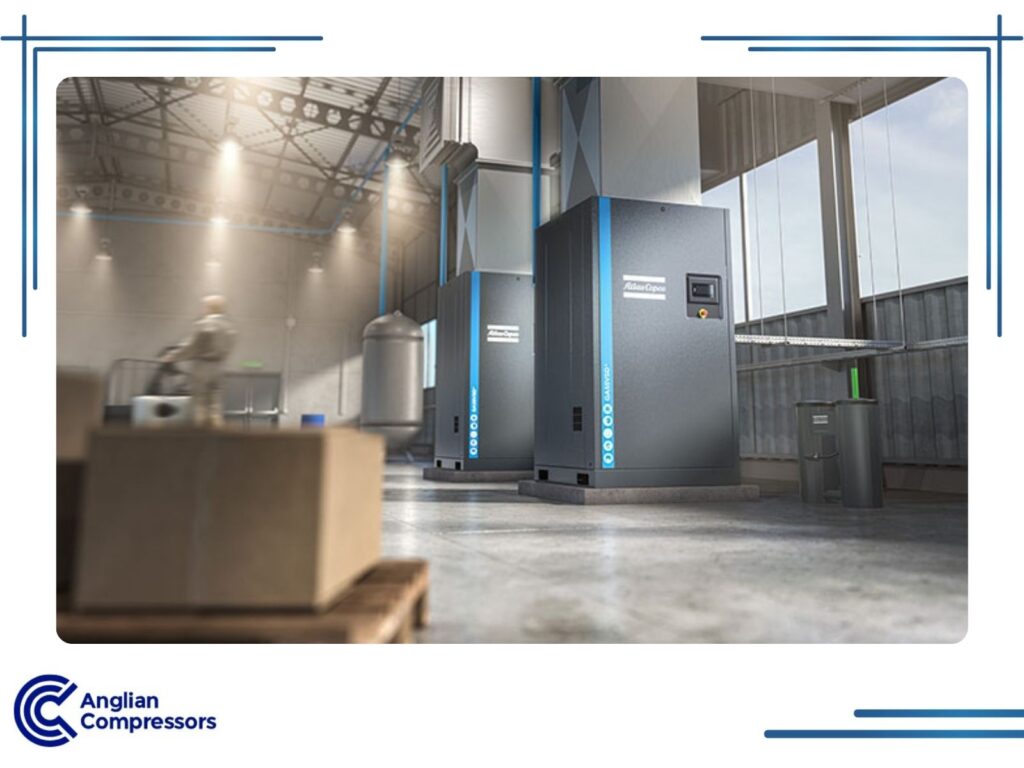What is a VSD Air Compressor?
For those new to the air compressor industry, it can be difficult to understand the different types of air compressors and understand the differences between them.
In this article, we will focus primarily on understanding variable speed drive air compressors and why they are appropriate for modern manufacturers. We’ll also draw comparisons to fixed-speed drive compressors for comparison and clarity.
Table of Contents
What is a VSD Air Compressor?
Previously, only fixed-speed air compressors existed. These were often rotary screw, single-speed versions where the compressor operated at a set RPM. While the fixed-speed compressor could perform the task, it used more energy and was costlier.
The market leader in air compressors – Atlas Copco – has for many decades innovated its line of air compressors. Perhaps the most significant advancement is their variable speed drive (VSD) models that help manufacturers better control their operating expenses.
The result has been that VSD air compressors offer the latest features while significantly reducing energy costs.
Understanding the Technical Aspects of a VSD Air Compressor
Air compressors have come a long way, with VSD technology and innovation shaping their evolution. To demystify the jargon behind a VSD air compressor and make it more digestible, let’s break down the components and processes.
Components that Make VSD Possible
Innovance Inverters: At the heart of VSD technology are inverters. Innovance inverters regulate the power supply to the compressor motor, ensuring that it operates at the necessary speed. This means that instead of running constantly, the motor speed adjusts to the air demand, which leads to energy savings.
GHH Rand Airends: Airends are essentially the components where air compression takes place. GHH Rand airends are renowned for their efficiency and reliability. They play a pivotal role in ensuring the compressor delivers consistent, high-quality compressed air.
Siemens Controls: Think of this as the brain of the operation. Siemens controls manage the overall functioning of the compressor. They monitor conditions, make adjustments in real time, and ensure the compressor is running optimally. This also means fewer breakdowns and lower maintenance costs.
SKF Bearings: Bearings are vital in any machinery with moving parts. SKF bearings, in particular, are known for their durability and longevity. They reduce friction between moving parts, ensuring smooth operation and minimizing wear and tear.
The Role of Oil-Free Compression Chambers and Teflon Coatings
Clean, oil-free air is crucial in various industries like food processing, electronics, and pharmaceuticals. Traditional compressors use oil for lubrication, sometimes contaminating the compressed air. Oil-free compression chambers in VSD air compressors ensure that the air produced is clean and free from any oil contaminants.
The Teflon coatings further enhance this process. These coatings, known for their non-stick and low-friction properties, ensure the smooth operation of components, reduce wear, and prevent any potential contaminants from sticking to the inner surfaces. This leads to consistently pure compressed air, essential for many industrial applications.
Benefits of VSD Compressors
The rise of VSD (Variable Speed Drive) compressors isn’t just a fad; it’s a step towards smarter machinery. Whether you’re a business owner looking to save costs or an environmental enthusiast keen on reducing carbon footprints, VSD compressors offer benefits that cater to a wide range of needs.
Let’s dive into the primary advantages of employing these advanced devices.
Energy Savings: Improved Efficiency
One of the most direct benefits of VSD compressors is the considerable energy savings they bring. Traditional compressors run at a constant speed, regardless of the demand, leading to energy wastage. With VSD compressors, it’s a different story.
VSD air compressors adjust their speed to the required air demand, ensuring they consume power only when necessary. The result? You can save up to a whopping 30% on energy costs, offering a significant boost to your bottom line.
VSD compressors are smarter. By matching energy use with demand, they ensure that no power goes to waste. This dynamic operation ensures that your compressor isn’t just working hard, but it’s working smart.
Constant Pressure Delivery and Reduced Power Surges
Inconsistent pressure can be a nightmare for many industrial processes. VSD compressors shine in this aspect by delivering steady and constant pressure.
Additionally, by running at variable speeds, they drastically reduce the chances of power surges, ensuring a stable power consumption pattern and reducing the risk of potential electrical issues.
Environmental Benefits: Our Planet Thanks You
In today’s age, being eco-friendly isn’t just a choice; it’s a responsibility. The environmental benefits of VSD compressors are compelling. By consuming less energy, they directly contribute to a reduction in carbon emissions.
To put things into perspective, for every kilowatt-hour (kWh) of electricity saved, approximately 0.92 pounds of CO2 emissions are avoided (based on average U.S. grid emission factors). If a VSD compressor saves, let’s say, 10,000 kWh annually, that translates to avoiding about 9,200 pounds of CO2 emissions in a year! That’s equivalent to planting over 100 trees.
What makes a Variable Speed Drive Air Compressor Different?
A VSD compressor uses an on-demand approach, compared to an always-running one, as is the case with fixed-speed air compressor technologies.
Due to greater operational flexibility, managed compressed air demand allows a compressor to use far less power. Indeed, when it isn’t required to be used for a period, a VSD compressor can be stopped completely.
Whilst unloading can be necessary when stopping specific air compressor systems, this isn’t required with high-quality variable-speed systems.
A flexible approach to compressed air generation is possible due to advanced components. These permit an inverter to limit the voltage sent to the VSD compressor. The motor speed is altered to run at the RPM necessary to produce the volume of compressed air at the required (BAR) pressure level. As a result, energy consumption is reduced through less wastage.
A sophisticated onboard controller allows an operator to manage the motor’s RPM, depending on air generation specifications. The advanced electronic controls let an operator respond quickly to fluctuating demand in volumes and pressure levels, to satisfy manufacturing requirements.

you outstanding sustainability, reliability and
performance, while minimizing the total cost
of ownership.
Applications of VSD Compressors
Variable Speed Drive (VSD) compressors aren’t just the latest buzzwords in the world of technology; they’re powerful tools with a broad range of applications across various industries. Whether keeping a factory line humming or ensuring that medicines are produced in pristine environments, VSD compressors are making a mark everywhere. Here’s a closer look at where they’re proving to be game-changers.
Industries that Benefit the Most
Pharmaceutical: Producing medicines requires precision and utmost purity. With VSD compressors, pharmaceutical companies can maintain controlled environments, ensuring both the efficiency and quality of production.
Automotive: The automotive industry has a vast need for compressed air equipment, whether for painting cars or powering pneumatic tools. VSD compressors offer the reliability and adaptability this fast-paced industry needs.
Manufacturing: From crafting toys to making furniture, manufacturers rely on the efficiency of their machinery. With the ability to match power consumption to demand, VSD compressors help factories run smoothly and economically.
Electronics: In the delicate world of electronics, even a speck of dust can spell disaster. VSD compressors provide clean and consistent air, which is essential for tasks such as assembling delicate components or cleaning circuit boards.
Specific Applications
Air Curtains: Have you ever noticed that gust of air when you walk into some stores or buildings? That’s an air curtain, designed to keep the external environment separate from the inside. VSD compressors help power these curtains, adjusting the airflow based on external conditions.
PCB Board Cleaning: Printed Circuit Boards (PCBs) are the backbone of most electronic devices. Cleaning them requires precision and purity, which VSD compressors provide by offering clean, oil-free air to eliminate contaminants.
Product Drying: Whether it’s freshly painted toys or a batch of freshly baked cookies, drying is a crucial step in many production processes. VSD compressors provide consistent airflow for efficient drying without over-consuming energy.
From the cars we drive to the phones in our pockets, the influence of VSD compressors is vast and varied. As industries continue to evolve, the role of these compressors is set to become even more indispensable.
When a VSD Compressor Makes Sense
Every manufacturer has different requirements. For those who regularly require compressed air, there can be a significant cost to that need.
When demand changes daily or even hour-to-hour, this presents a problem for fixed-speed air compressor systems. You’re stuck either leaving them operating continually at full speed, or turning them off and back on as needed.
By contrast, a VSD compressor makes sense when a business operation has varying needs, such as multiple shifts supporting a 24/7 operation. These air compressors can be turned on without idle up first. Each shift can configure the unit specific to their requirements for required volumes and pressure levels.
For example, an Atlas Copco VSD compressor unit is compact, runs below 70 decibels, and includes remote monitoring. OPC UA on production installations allows smart production equipment to communicate, where necessary.
Air pressure sensitivity is a consideration in some plants, too. Inlet valves managing airflow in fixed-speed compressors contribute up to 30 PSIG plus or minus the required pressure level. VSD compressors, controlled by electronic systems rather than valves, manage pressure levels down to a 2 PSIG variance.
Heat recovery is strong with improved VSD systems. Also, energy consumption is reduced by up to 60 per cent compared to older models of compressors.
Furthermore, when an energy supplier levies penalties for high spikes in demand – like those caused by turning on a fixed-speed air compressor – VSD compressors avoid this additional expense.
Choosing the Right VSD Compressor for Your Needs
The VSD compressor market can feel like stepping into a tech wonderland. With a myriad of options and specs, how do you determine which one is just right for you? Let’s simplify the process by spotlighting some key factors and their relevance.
Factors to Consider
Motor Size: Think of the motor as the heart of your compressor. The size determines how much power it can deliver. Consider your operations and their intensity. Do you require a compressor that runs occasionally, or do you need a workhorse that goes on for hours? Choose a motor size that aligns with your usage to ensure longevity and efficiency.
Capacity: Capacity dictates the volume of air a compressor can supply. It’s vital to gauge the amount of compressed air your tasks demand. An undersized compressor might leave your machines gasping for air, while an oversized one could mean unnecessary costs.
Receiver Size: The receiver, or storage tank, holds the compressed air. A larger receiver provides a buffer, reducing the frequency with which the compressor needs to start and stop, leading to less wear and tear. Determine the storage you need based on the peak demand periods of your operations.
The Crucial Role of Professional Air Audits
Before diving into a purchase, there’s one more thing that can guide you towards the best choice: a professional air audit. This isn’t just a fancy term; it’s a comprehensive assessment of your air needs.
Professional air audits evaluate your current air consumption, detect leaks, and provide insights into potential energy savings. By understanding the intricate details of your operations and the actual air demand, these audits ensure you select a compressor that’s a perfect fit, neither too big nor too small.
Does a Fixed Speed Drive Compressor Ever Make Sense?
For manufacturers that require a set pressure level and a steady volume of compressed air, with few interruptions, fixed-speed air compressors might be a reasonable compromise.
However, as all business leaders acknowledge, industry requirements can change dramatically. Being highly adaptable to altered demand levels essentially gives manufacturers a trump card up their sleeve. If you’re only using a fixed-speed compressor, it’s unable to stay nimble or make rapid adjustments to accommodate different, more minor production requirements.
Internal factors may come into play, too. A damp or unclean product environment favours fixed speed over a variable-speed drive compressor. VSD includes electronics that work best in drier conditions. Modern manufacturing facilities rarely have this concern, though.
Consistent energy flow is also a factor. VSD compressors require a smooth energy source, rather than dirty energy that’s poorly regulated. Sensitive electronics are vulnerable to inferior power delivery. However, for most major cities and towns, this isn’t a major worry.
Choose Between Fixed Speed and Variable Speed Drive Air Compressors
Typically, busy production environments benefit from having more options, not fewer.
Fixed speed and variable speed drive air compressors aren’t always an either/or scenario. In some circumstances, manufacturers may prefer to keep and maintain existing fixed-speed compressors while augmenting their compressed air capabilities by adding one or more VSD compressors.
The mix ‘n’ match approach might be appropriate where demand remains constant for some production requirements, but a growing need to adapt on the fly is evident, too.
While phasing out the fixed speed models over time would still make sense, some facilities may look to completely overhaul their compressors by replacing them all with variable speed technologies.
A professional air audit is worth considering if you’re unsure whether upgrading or choosing a VSD is worthwhile. An audit factors in expected usage patterns in a compressed air environment.
Anglian Variable Speed Compressors
Contact Anglian Compressors today to learn more about our 50 years of experience in the compressor industry. We are the leading provider of VSD compressors in the UK, and our products are backed by a team of experts dedicated to providing you with the best possible service.


